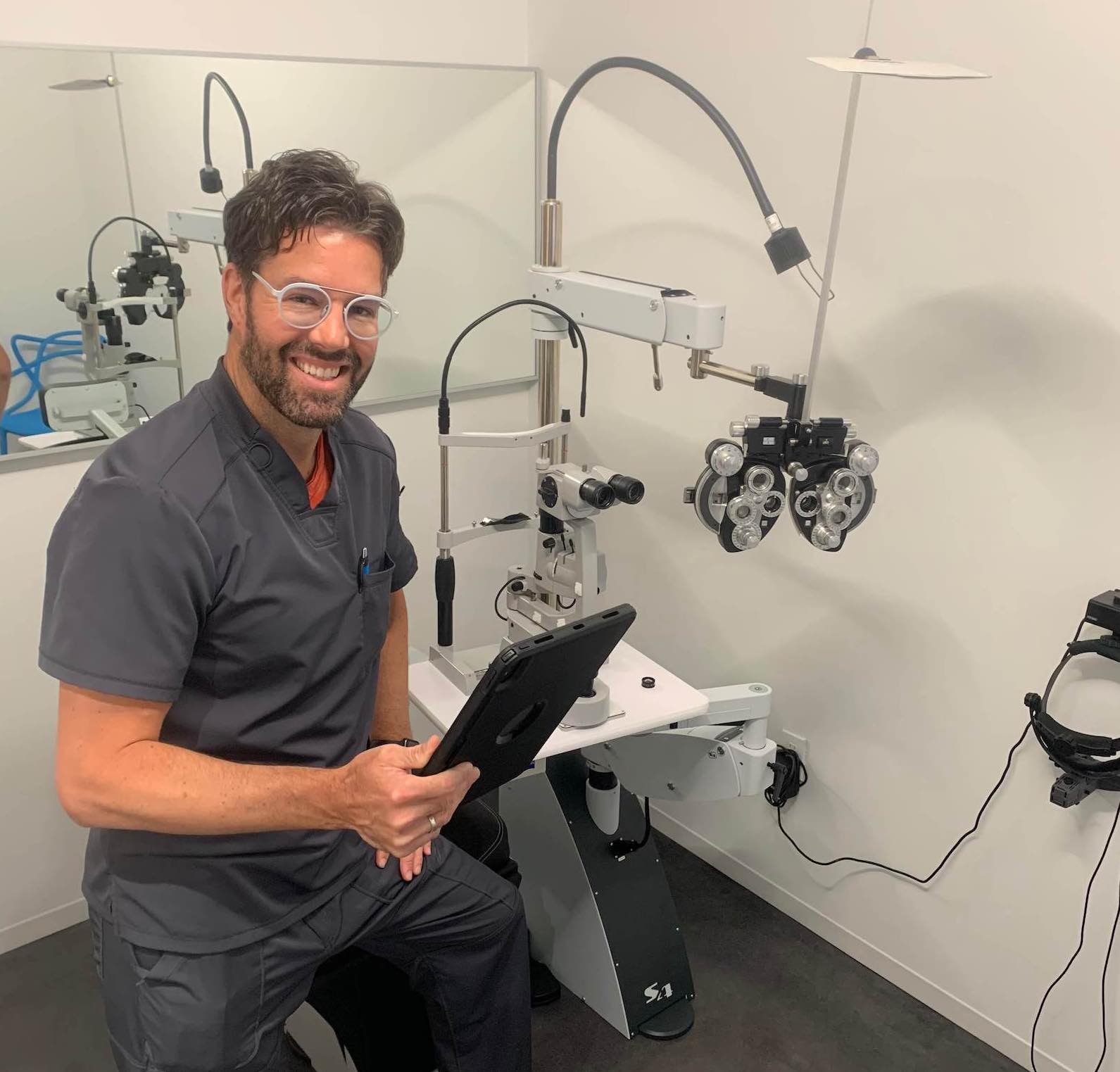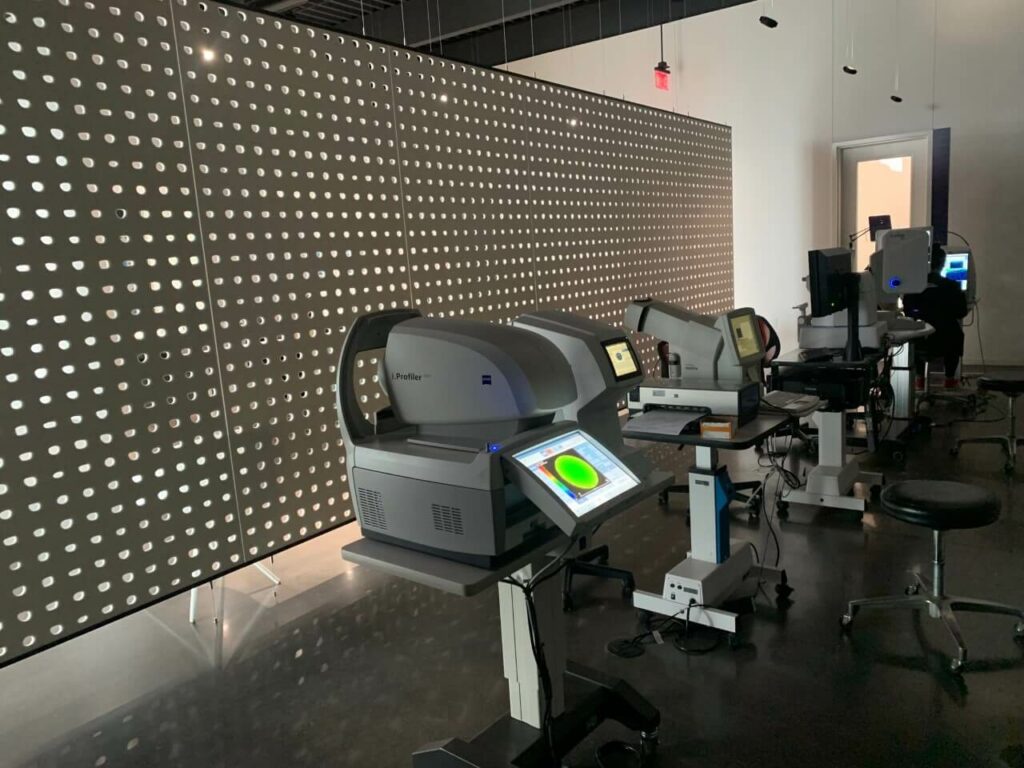When you go for your eye exam, the doctors at CHROMA modern Eyewear Eyecare don’t only test your vision. We assess your overall eye health, observe the structure of the eyes, and look for signs of early stages of eye diseases.
Optical Coherence Tomography (OCT) is one imaging tool we can use to take detailed cross-sectional pictures of your retina. OCT tests can identify retina-related eye conditions such as macular degeneration or glaucoma, and indicate to your optometrist that you need further tests.
Understanding Optical Coherence Tomography
OCT technology provides high-resolution, cross-sectional images of your retina. Unlike X-rays or other 2D images, your optometrist can see the retina’s distinctive layers at multiple depths, aiding in the diagnosis of several eye diseases.
It can be used to see the fine-detailed structures of the optic nerve, macula, choroid, and retina. If there’s fluid build-up, ocular structure dysfunction, or swelling, OCT helps pinpoint the problem in the exact structural layer.
The doctors at CHROMA use this effective tool because:
- It’s comfortable for patients
- It has no radiation and usually doesn’t require eye dilation
- It’s non-invasive
How Does OCT Work?
Experts draw parallels between OCT and ultrasounds, but OCT uses light rather than sound. The non-invasive test sends light beams into the eyes, which are then bounced back to the sensors. Just like an ultrasound uses sound echoes to visualize tissues and organs in your body, OCT images tell the machine the size and shape of the eye’s structures in real-time.
With this imaging tool, our doctors at CHROMA can begin treating the right condition immediately, reducing assumptions and the process of elimination.
An OCT is one of the easiest and most comfortable medical imaging tests you’ll ever take. Your technician will have you look at a light, and we’ll receive the image immediately. We can then assess the images and discuss your results, taking note of any abnormalities that we need to address.
Diagnosing Eye Conditions with OCT
If you’re at high risk for developing an eye condition, our doctors at CHROMA modern Eyewear Eyecare may use OCT during your comprehensive eye exam to monitor your eyes for signs of diseases.
If you have a pre-existing medical condition that can affect your eyes, like diabetes or prediabetes, or are at higher risk, OCT tests can detect early warning signs before they cause unmanageable problems.
Severe eye conditions can lead to total vision loss if not managed. Some of the most prevalent eye conditions that OCT can help diagnose include:
Glaucoma
Glaucoma is a group of eye conditions that damage the optic nerve, with little to no early warning signs indicating its development. It’s one of the leading causes of vision loss in adults.
When you have open-angle glaucoma, the most common type, fluid build-up in your eyes raises the intraocular pressure (IOP), causing optic nerve damage. A blockage in the drainage channel causes the pressure to build in your eyes over time until your vision begins to fade.
Book an appointment with our doctors at CHROMA modern Eyewear Eyecare if you’re experiencing symptoms such as:
- Vision loss
- Seeing halos around lights
- Eye redness
- Eyes that look hazy
- Eye pain
Acute onset of these symptoms is an eye emergency, and you should seek care immediately.
OCT can help detect changes in IOP to obtain a glaucoma diagnosis. It can also monitor your diagnosed glaucoma as the disease progresses.

Age-Related Macular Degeneration
AMD is the gradual loss of central vision due to the breakdown of the macula, a part of the retina. It’s one of the leading causes of vision loss. This can result from aging, as the part of the eye that keeps vision sharp wears down. AMD can develop in different ways: some patients have a slow onset, and in others, it happens faster.
Early stages of AMD don’t have symptoms, and some people experience blurry central vision brought on by the condition but assume it’s a normal part of aging. The few signs of AMD include:
- Mild blurriness in central vision, with side vision intact
- Difficulty seeing in low-light conditions
- Wavy appearance of straight lines
- Dulling of colors
When our doctors use OCT to detect AMD, the images can show:
- Drusen, or protein deposits on the macula
- Thinning of the retina
- Abnormal blood vessels in the eye
- Damage or bleeding in the macula
OCT is becoming a standard test for macular degeneration. If you have risk factors for AMD, an OCT test can get a clearer view of the macula and potentially find damage or deterioration before symptoms appear.
Diabetic Retinopathy
If you have diabetes, you’re at risk of developing diabetic retinopathy. Uncontrolled blood sugar can cause damage to the blood vessels in the retina, resulting in blurry vision, difficulty seeing color, and, ultimately, vision loss if left untreated.
When the blood vessels leak blood and other fluids into the eye, the retina’s tissue can swell and obstruct vision. Diabetic retinopathy can cause issues in the eye, such as:
- Focus that goes in and out
- Impaired color vision
- Floaters, specks, or shapes that appear to float in your field of vision
- Blockage of vision due to hemorrhage inside the eye
- Difficulty with night vision
- Vision loss
OCT imaging can get pictures of the blood vessels in the eye. If our optometrists recognize problems with blood flow, blockages, and changes in blood vessels, it can help us achieve a conclusive diagnosis of diabetic retinopathy.
Other Eye Conditions That Benefit from OCT
OCT can help diagnose and manage other eye conditions, including:
- Cystoid macular edema
- Macular pucker
- Macular hole
- Central serous retinopathy
- Cone and cone-rod dystrophies
- Tumors in your choroid and retina
Keep an Eye on Your Ocular Health
OCT is just one of many tools our doctors at CHROMA can use to monitor your eye health. A regular eye exam schedule can help us keep your ocular health and vision at their best. If you’re due for your annual eye exam, schedule an exam at CHROMA modern Eyewear Eyecare in the heart of Fort Worth’s cultural district to preserve your eyesight.



